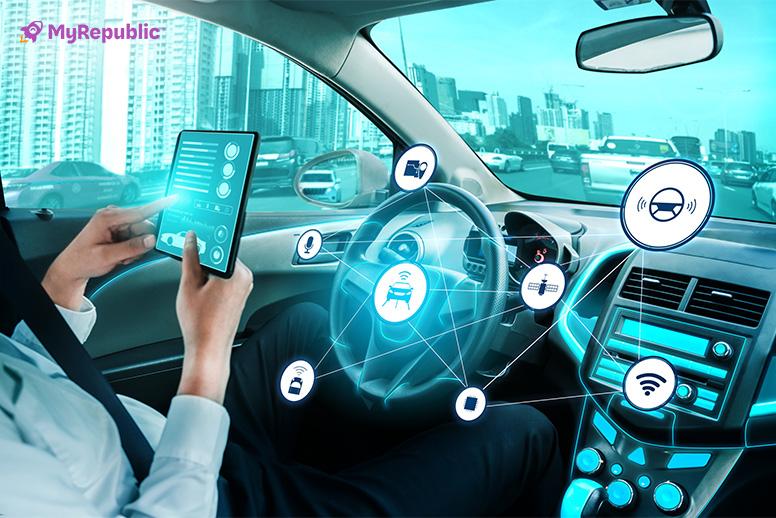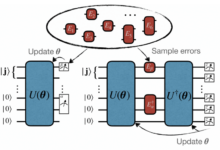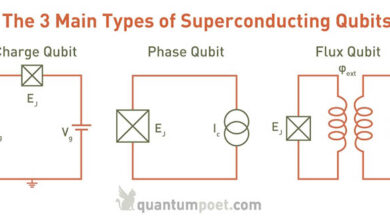5G in Autonomous Vehicles The Future of Driving
5G in autonomous vehicles is revolutionizing the automotive industry. Imagine a world where self-driving cars seamlessly navigate complex traffic situations, communicate instantly with infrastructure, and react to unexpected events with unparalleled precision – this is the promise of 5G. This technology isn’t just about faster internet in your car; it’s about building a safer, more efficient, and connected transportation ecosystem.
The ultra-low latency and high bandwidth offered by 5G are crucial for the real-time data processing required by autonomous driving systems, enabling features that were previously impossible.
This integration isn’t without its challenges. Deploying robust 5G networks capable of handling the massive data demands of countless autonomous vehicles requires significant infrastructure investment and careful consideration of security and privacy implications. However, the potential benefits – reduced accidents, improved traffic flow, and enhanced accessibility – make the pursuit of 5G-enabled autonomous vehicles a worthwhile endeavor.
5G Network Infrastructure for Autonomous Vehicles
Autonomous vehicles (AVs) rely heavily on constant, reliable communication for safe and efficient operation. 5G’s high bandwidth, low latency, and high reliability make it a crucial technology for enabling widespread AV adoption. However, simply having 5G isn’t enough; a robust and specifically designed network infrastructure is essential.
A 5G network supporting autonomous vehicles requires a sophisticated architecture incorporating several key components. These components work together to provide the necessary communication capabilities for AVs to perceive their environment, make decisions, and communicate with other vehicles and infrastructure. The seamless integration of these elements is vital for a safe and efficient autonomous driving experience.
Essential Components of a 5G Network for Autonomous Vehicles
Several critical components work in concert to create a reliable 5G network for AVs. These include a range of base stations, core network infrastructure, and edge computing capabilities. The specific implementation will vary depending on the deployment environment and density of AVs.
- High-density Base Stations: A high concentration of base stations, including macrocells, small cells, and potentially mmWave deployments, is necessary to provide consistent coverage and sufficient bandwidth for the numerous connected vehicles. The density is particularly crucial in urban areas and along high-traffic roadways.
- Advanced Core Network: The core network manages the flow of data between AVs and other network elements. It needs to be highly scalable and capable of handling the massive data volumes generated by numerous connected vehicles simultaneously. This often involves software-defined networking (SDN) and network function virtualization (NFV) for enhanced flexibility and management.
- Edge Computing: Processing data closer to the source (the AVs) reduces latency, which is critical for real-time decision-making in autonomous driving. Edge computing servers process data from sensors and cameras, enabling faster responses to dynamic situations.
- Network Security: Robust security measures are crucial to protect against cyberattacks that could compromise the safety and integrity of AVs. This includes encryption, authentication, and intrusion detection systems.
Network Slicing for Optimized 5G in Autonomous Driving
Network slicing allows the creation of virtual networks within the physical 5G infrastructure, each tailored to specific needs. This is particularly important for AVs, as their communication requirements differ significantly from other applications. By dedicating slices to AVs, network operators can guarantee the necessary quality of service (QoS) parameters.
5G’s low latency is crucial for the real-time data processing needed by autonomous vehicles. However, optimizing the AI algorithms driving these vehicles requires immense computing power, which is where the challenges highlighted in this article on Quantum AI hardware development and its challenges in scalability become relevant. Overcoming these scalability issues is key to unlocking the full potential of truly autonomous driving, ensuring safe and efficient navigation.
For example, one slice might prioritize low latency for critical sensor data transmission, while another slice handles higher-bandwidth applications like high-definition map updates. This customized approach ensures that AVs always receive the required network resources, regardless of overall network load. This efficient resource allocation improves overall network performance and enhances the safety and reliability of autonomous driving systems.
Challenges in Deploying and Maintaining a Reliable 5G Network for Autonomous Vehicles
Deploying and maintaining a reliable 5G network for widespread autonomous vehicle use presents significant challenges. These challenges span technical, economic, and regulatory aspects.
High initial investment costs, spectrum availability, and ensuring consistent coverage across diverse geographical areas all contribute to the complexity. Further challenges include maintaining network reliability in adverse weather conditions and mitigating the effects of interference.
Comparison of 5G Network Deployment Strategies
Different deployment strategies offer various trade-offs in terms of cost, coverage, and capacity. The optimal strategy depends on the specific deployment environment and requirements.
| Deployment Strategy | Coverage | Capacity | Cost | Latency |
|---|---|---|---|---|
| Macrocells | Wide area | High | High | Relatively High |
| Small Cells | Localized | Moderate | Moderate | Low |
| mmWave | Short range, high-density | Very High | High | Very Low |
Communication Protocols and Data Transmission: 5G In Autonomous Vehicles
Autonomous vehicles rely heavily on seamless and reliable communication to navigate safely and efficiently. The ability to exchange data with other vehicles, infrastructure, and pedestrians (V2X communication) is paramount, and 5G technology plays a crucial role in enabling this. Different communication protocols are employed, each with its own strengths and weaknesses concerning latency, bandwidth, and reliability. Understanding these protocols is key to grasping the challenges and opportunities presented by 5G in the autonomous driving space.The success of autonomous driving hinges on real-time data transmission.
Sensors on the vehicle constantly collect data about its surroundings, and this information must be processed and acted upon almost instantaneously. Delays in communication can lead to accidents, making latency a critical factor in the design and implementation of V2X systems. Different communication protocols offer varying levels of performance, which directly impact the safety and efficiency of autonomous vehicles.
5G’s low latency is crucial for the real-time data exchange needed by autonomous vehicles. Efficient route planning for these vehicles is a major challenge, but this could be significantly improved by advancements in logistics optimization. Check out this article on Quantum AI’s potential in solving optimization problems in logistics to see how this technology might help.
Ultimately, better logistics translate to more efficient autonomous vehicle deployments and improved traffic flow.
Latency Requirements for Real-Time Data Transmission
Autonomous driving necessitates extremely low latency for reliable operation. Reaction times need to be measured in milliseconds, not seconds. For example, a vehicle needs to react instantly to an emergency braking signal from a nearby car or to avoid an unexpected obstacle. Typical latency targets for critical V2X applications are in the range of 10-50 milliseconds, though some applications may tolerate slightly higher latency depending on their criticality.
5G’s low latency is crucial for the real-time data processing needed by autonomous vehicles. This rapid communication is vital for safe and efficient operation, but the technology’s impact extends beyond the road. Consider the environmental impact; improving climate models is key, and learning about Quantum AI’s potential to solve complex climate change modeling problems highlights how technology can address broader challenges.
Ultimately, 5G’s role in autonomous vehicles helps pave the way for a more sustainable future by enabling efficient transportation and supporting research into solutions like Quantum AI.
Anything beyond this range could significantly compromise safety and the smooth operation of the autonomous system. Exceeding these latency thresholds could result in collisions or other dangerous situations. The precise latency requirements will depend on factors like the speed of the vehicle, the density of traffic, and the specific application.
Comparison of Communication Protocols: LTE-V2X and 5G NR-V2X
Several communication protocols are used for V2X communication, with LTE-V2X and 5G NR-V2X being prominent examples. Both leverage cellular networks, but 5G NR-V2X offers significant improvements over its predecessor.
- LTE-V2X:
- Advantages: Wide deployment, relatively mature technology, cost-effective in areas with existing LTE infrastructure.
- Disadvantages: Higher latency compared to 5G NR-V2X, limited bandwidth, susceptible to interference.
- 5G NR-V2X:
- Advantages: Much lower latency, significantly higher bandwidth, improved reliability and resilience to interference, supports more complex applications.
- Disadvantages: Requires new infrastructure deployment, higher initial costs compared to LTE-V2X, not yet as widely deployed as LTE.
The superior performance of 5G NR-V2X in terms of latency and bandwidth is crucial for enabling the advanced capabilities required for fully autonomous driving. For instance, the higher bandwidth allows for the transmission of richer sensor data, improving the accuracy of the vehicle’s perception of its environment. The lower latency ensures quicker reaction times to critical events, enhancing safety.
While LTE-V2X can support some autonomous driving features, 5G NR-V2X is essential for realizing the full potential of this technology.
Data Security and Privacy in 5G-Enabled Autonomous Vehicles
The integration of 5G technology into autonomous vehicles promises significant advancements in safety and efficiency. However, this connectivity also introduces new and significant security and privacy challenges. The sheer volume of data transmitted and the potential consequences of a security breach necessitate a robust and multifaceted approach to safeguarding both the vehicle and its occupants. This section will explore potential vulnerabilities, propose a secure communication architecture, and discuss the ethical considerations surrounding data collection and usage.
Potential Security Vulnerabilities in 5G Networks for Autonomous Vehicles
Autonomous vehicles rely heavily on real-time data transmission for navigation, obstacle detection, and communication with other vehicles and infrastructure. This reliance creates several potential attack vectors. Compromising this data flow could lead to accidents, data theft, or even remote control of the vehicle. Examples of vulnerabilities include denial-of-service attacks that overwhelm the network, man-in-the-middle attacks intercepting and altering data, and software vulnerabilities exploited to gain unauthorized access to the vehicle’s systems.
Furthermore, the complexity of the 5G network itself, with its multiple interconnected components, increases the potential attack surface.
Secure Communication Architecture for Protecting Sensitive Data
A robust security architecture is crucial to mitigating these risks. This architecture should incorporate multiple layers of security, including encryption at all levels of communication, authentication mechanisms to verify the identity of communicating entities, and intrusion detection systems to monitor network traffic for suspicious activity. Data transmitted between the vehicle and the network should be encrypted using strong, industry-standard algorithms like AES-256.
Regular software updates are essential to patch known vulnerabilities and implement security improvements. Furthermore, a secure hardware platform, resistant to physical tampering, is necessary to protect sensitive components. Implementing blockchain technology for data integrity and secure data logging could further enhance security. The use of microsegmentation to isolate critical vehicle functions from less critical ones also enhances security.
Ethical Implications of Data Collection and Usage in Autonomous Vehicle Systems, 5G in autonomous vehicles
Autonomous vehicles collect vast amounts of data, including location information, driving behavior, and sensor data. The ethical implications of collecting and using this data are significant. Concerns include the potential for misuse of personal data, the lack of transparency regarding data collection practices, and the potential for bias in algorithms used to process this data. Data minimization principles should be applied, collecting only the data necessary for the intended purpose.
Clear and informed consent should be obtained from users regarding data collection and usage. Robust data anonymization techniques should be implemented to protect individual privacy. Finally, independent audits and oversight mechanisms are essential to ensure ethical data handling practices.
Data Security Measures and Their Effectiveness
| Security Measure | Effectiveness | Description |
|---|---|---|
| Encryption (AES-256) | High | Encrypts data in transit and at rest, protecting it from unauthorized access. |
| Authentication (Public Key Infrastructure) | High | Verifies the identity of communicating devices, preventing impersonation attacks. |
| Intrusion Detection System (IDS) | Medium | Monitors network traffic for malicious activity and alerts administrators to potential threats. |
| Regular Software Updates | Medium-High | Patches vulnerabilities and improves security over time. |
| Data Anonymization | High | Removes personally identifiable information from data sets, protecting individual privacy. |
| Secure Hardware Platform | High | Protects sensitive components from physical tampering. |
Impact of 5G on Autonomous Vehicle Capabilities
- G’s impact on autonomous vehicles is transformative, significantly improving their performance, safety, and efficiency. The ultra-low latency, high bandwidth, and massive connectivity offered by 5G networks are key enablers for the next generation of self-driving cars. This allows for faster data processing, more reliable communication, and ultimately, a safer and more efficient driving experience.
- G improves the precision and responsiveness of autonomous driving systems by providing the necessary infrastructure for real-time data exchange between the vehicle and its surroundings. This includes high-speed communication with other vehicles (V2V), infrastructure (V2I), and the cloud (V2X), enabling the autonomous system to react more quickly and accurately to dynamic situations on the road. The reduction in latency, compared to previous generations of cellular technology, is crucial for precise navigation and obstacle avoidance.
This near-instantaneous communication is vital for making critical driving decisions in milliseconds.
5G’s Role in Advanced Driver-Assistance Systems (ADAS)
G facilitates the seamless integration and operation of advanced driver-assistance systems (ADAS). These systems, which range from adaptive cruise control to lane keeping assist, rely heavily on real-time data processing and communication. The high bandwidth of 5G allows for the transmission of large amounts of sensor data, such as high-resolution camera images and lidar point clouds, enabling more accurate and reliable ADAS functionality.
For example, 5G’s speed enables quicker processing of data from multiple sensors, allowing for more precise object detection and classification, improving the effectiveness of automatic emergency braking systems. Furthermore, the enhanced connectivity allows for improved communication between the vehicle and traffic management systems, leading to smoother traffic flow and reduced congestion.
Examples of 5G Enhancing Autonomous Vehicle Safety and Efficiency
The following table illustrates how 5G connectivity enhances various aspects of autonomous vehicle operation:
| Impact Area | Example | Explanation |
|---|---|---|
| Safety | Improved object detection and avoidance | High-bandwidth 5G allows for the near-instantaneous transmission of high-resolution sensor data, enabling faster and more accurate object detection and classification, leading to quicker reactions in emergency situations. This improves the effectiveness of automatic emergency braking and lane keeping assist systems. |
| Safety | Enhanced V2X communication | 5G enables reliable communication between vehicles (V2V), infrastructure (V2I), and the cloud (V2X), allowing vehicles to share real-time information about their location, speed, and trajectory. This helps prevent collisions and improves overall traffic safety. For instance, a vehicle could receive a warning about an upcoming hazard from another vehicle or a traffic management system. |
| Efficiency | Optimized traffic flow management | 5G enables real-time communication between autonomous vehicles and traffic management systems, allowing for optimized traffic flow and reduced congestion. This can lead to shorter travel times and reduced fuel consumption. |
| Functionality | Remote diagnostics and updates | 5G’s high bandwidth and low latency allow for remote diagnostics and over-the-air software updates, reducing downtime and improving the overall performance and reliability of autonomous vehicles. This means faster resolution of issues and seamless integration of new features. |
| Functionality | Advanced driver assistance features | 5G supports the implementation of more sophisticated ADAS features, such as automated lane changing and adaptive cruise control, improving the overall driving experience and enhancing safety. The high-speed data transfer allows these features to operate more smoothly and accurately. |
Challenges and Future Trends
Integrating 5G with autonomous driving presents a complex interplay of technological advancements and inherent limitations. While 5G offers significant improvements in speed and latency, several hurdles remain before fully realizing its potential in autonomous vehicles. Future advancements in both 5G and autonomous vehicle technology will be crucial in overcoming these challenges and unlocking the true potential of this synergy.The successful deployment of 5G for autonomous vehicles hinges on addressing several key technological challenges and anticipating future trends in both network infrastructure and vehicle technology.
This necessitates a proactive approach to research and development, focusing on areas such as network reliability, security, and scalability. Further, the evolution of 5G itself will significantly impact the capabilities and limitations of autonomous vehicles.
Remaining Technological Hurdles
Several technological hurdles currently impede the seamless integration of 5G with autonomous driving. These challenges range from ensuring reliable connectivity in diverse environments to managing the massive data streams generated by autonomous vehicles. Addressing these issues requires a multifaceted approach involving advancements in both hardware and software. For instance, the need for ultra-reliable low-latency communication (URLLC) in autonomous driving demands significant improvements in network infrastructure and error correction techniques.
Furthermore, the security of data transmitted over the network is paramount, requiring robust cryptographic protocols and security mechanisms to prevent unauthorized access or manipulation. Finally, the sheer volume of data generated by autonomous vehicles necessitates efficient data compression and transmission techniques to avoid network congestion.
Potential Future Advancements in 5G and Their Implications
Future advancements in 5G technology are poised to significantly enhance the capabilities of autonomous vehicles. The evolution towards 6G and beyond will likely involve improvements in speed, latency, and bandwidth, enabling more sophisticated autonomous driving functionalities. For example, the increased bandwidth will allow for the transmission of high-resolution sensor data, leading to improved object recognition and decision-making. Reduced latency will enable faster reaction times to dynamic driving situations, enhancing safety and responsiveness.
Moreover, advancements in network slicing will allow for the prioritization of autonomous vehicle traffic, ensuring reliable connectivity even under heavy network load. This will be crucial in scenarios such as busy urban environments or during emergency situations. Consider the example of a fleet of autonomous delivery vehicles; improved 5G infrastructure could allow for real-time coordination and optimized routing, leading to increased efficiency and reduced delivery times.
Anticipated Evolution of 5G Network Infrastructure
The increasing deployment of autonomous vehicles necessitates a significant evolution of 5G network infrastructure to support the growing demands for connectivity, bandwidth, and reliability. This evolution will involve several key developments:
The expansion of 5G network coverage is crucial to ensure seamless connectivity for autonomous vehicles across diverse geographical areas, including rural and remote regions. This will require increased deployment of base stations and the use of advanced antenna technologies to improve signal strength and coverage in challenging environments.
- Increased Density of Base Stations: Deploying a higher density of small cells and macro cells will improve network capacity and reduce latency, enabling more reliable communication for a larger number of autonomous vehicles.
- Edge Computing Deployment: Processing data closer to the source (edge computing) will reduce latency and improve responsiveness, enabling faster reaction times for autonomous vehicles. This is particularly important for time-critical applications such as emergency braking.
- Advanced Antenna Technologies: The use of massive MIMO (Multiple-Input and Multiple-Output) and beamforming technologies will improve signal quality and capacity, allowing for higher data rates and more reliable communication. This will be essential for supporting the high bandwidth demands of autonomous vehicles.
- Network Slicing: Network slicing will allow for the creation of dedicated network segments optimized for the specific needs of autonomous vehicles, ensuring reliable connectivity even under heavy network load. This will be crucial for guaranteeing the safety and reliability of autonomous driving.
- Artificial Intelligence (AI) for Network Optimization: AI-powered network management systems will optimize resource allocation and improve network performance, ensuring efficient use of bandwidth and reducing congestion. This will be vital for supporting the large-scale deployment of autonomous vehicles.
Illustrative Scenarios

Source: myrepublic.net
Let’s explore how 5G’s capabilities significantly enhance autonomous vehicle performance and communication in real-world situations. These scenarios highlight the crucial role of 5G’s high bandwidth, low latency, and massive connectivity in enabling safer and more efficient autonomous driving.
Autonomous Vehicle Navigation in a Complex Urban Environment
Imagine a self-driving car navigating a busy city center during rush hour. Traditional cellular networks might struggle to provide the real-time data needed for the vehicle to safely maneuver through dense traffic, unpredictable pedestrian movements, and constantly changing road conditions. However, with 5G, the autonomous vehicle receives a continuous stream of high-resolution data from various sources. High-definition cameras and sensors on the vehicle provide a detailed 360-degree view, while 5G’s low latency allows for near-instantaneous communication with other vehicles, traffic lights, and infrastructure.
The vehicle’s AI processes this information to make rapid, informed decisions, such as smoothly merging into traffic, safely crossing intersections, and avoiding potential collisions. The high bandwidth of 5G allows for the transmission of large amounts of sensor data, improving the accuracy of object detection and classification, and ultimately leading to a safer and more efficient driving experience.
The vehicle can also leverage 5G’s enhanced capabilities to anticipate potential traffic jams or accidents ahead, using real-time data from other vehicles and traffic management systems to adjust its route and speed accordingly. This dynamic adaptation to real-time conditions, facilitated by 5G, is a key element in improving the safety and efficiency of autonomous vehicles in complex urban settings.
5G’s low latency is crucial for the real-time data processing needed in autonomous vehicles, enabling rapid responses to changing conditions. This level of precision mirrors the advancements in personalized medicine, where the role of quantum AI in personalized medicine and healthcare requires incredibly fast and accurate analysis of patient data. Similarly, autonomous vehicles rely on this speed to ensure safe and efficient navigation.
Seamless Communication Between Autonomous Vehicles and Traffic Management Systems
The image depicts a bustling city intersection with multiple autonomous vehicles interacting with a centralized traffic management system. Each autonomous vehicle is equipped with 5G-enabled communication modules that transmit real-time data, including location, speed, and intended trajectory, to the traffic management system. The traffic management system, in turn, utilizes this data to optimize traffic flow, ensuring minimal congestion and delays.
The image shows a clear visualization of the communication flow – autonomous vehicles are represented by colorful icons transmitting data streams towards a central hub, which represents the traffic management system. The system’s response, displayed as light signals and speed adjustments on the vehicles, demonstrates the system’s dynamic control over the intersection. For instance, an autonomous vehicle approaching a red light receives a signal from the traffic management system, allowing it to slow down and stop smoothly, while another vehicle approaching from a different direction receives a signal to proceed safely through the intersection.
This real-time coordination, enabled by 5G’s high bandwidth and low latency, eliminates the need for traditional traffic signals in many cases, leading to smoother traffic flow and a significant reduction in congestion and travel times. The image also highlights the safety aspect, with the seamless communication minimizing the risk of accidents by providing autonomous vehicles with advance warning of potential conflicts and enabling them to make proactive adjustments.
The use of 5G ensures the reliable and timely transmission of this critical information, which is essential for maintaining safety and efficiency within the autonomous vehicle ecosystem.
Conclusion
The convergence of 5G and autonomous vehicle technology marks a pivotal moment in transportation. While challenges remain in deploying and securing these systems, the potential for transformative improvements in safety, efficiency, and accessibility is undeniable. As 5G networks expand and the technology matures, we can anticipate a future where autonomous vehicles become an integral part of our daily lives, reshaping urban landscapes and the way we travel.
The journey toward fully autonomous, 5G-connected vehicles is ongoing, but the destination promises a safer and more efficient transportation system for all.
FAQ
What are the main security risks associated with 5G in autonomous vehicles?
Potential security risks include hacking of vehicle control systems, data breaches leading to identity theft or manipulation of vehicle behavior, and denial-of-service attacks disrupting communication.
How does 5G improve the safety of autonomous vehicles compared to previous technologies?
5G’s low latency and high bandwidth enable faster reaction times to hazards, more accurate sensor data processing, and enhanced communication between vehicles and infrastructure, leading to safer autonomous driving.
What is the role of edge computing in 5G-enabled autonomous vehicles?
Edge computing processes data closer to the vehicle, reducing latency and improving the responsiveness of autonomous driving systems by minimizing reliance on distant cloud servers.
Will 5G be sufficient for the future needs of autonomous vehicles, or will we need 6G?
While 5G provides a significant leap forward, the ever-increasing demands of autonomous driving, particularly in terms of data volume and processing needs, might necessitate the eventual adoption of 6G or other advancements in wireless communication.
How will 5G impact the cost of autonomous vehicles?
The initial cost of implementing 5G capabilities in autonomous vehicles might be high, but the long-term benefits in terms of safety, efficiency, and reduced accidents could potentially offset these costs.









